Lets talk about Colpitts oscillator again (or the very basic circuit theory if you want). Suppose I modeled circuit as on the schematics below
I am interested in systematic ways of obtaining circuit state-space equations with no ad hoc computations. Modified nodal analysis works fine but for obvious reasons I am iterested in ODEs rather than DAEs. In this simplified circuit there is proper tree (blue edges) and (red) co-tree.
To formulate state equations I need to write KCL for each capacitor and its selected node or supernode (see 19.3 in the link).
Situation is straightforward if I choose \$+\$node \$+v_{C_{\mathrm{b}}^{\mathrm{d}}}\$. Then we are left with \begin{equation} \frac{\mathrm{d}v_{C_{\mathrm{b}}^{\mathrm{d}}}}{\mathrm{d}t} + i_{R_c} - \alpha_{\mathrm{F}}i_{\mathrm{E}} - i_{R_b} = 0 \end{equation}
Problem. Suppose, that I choose + node of \$v_{C_{\mathrm{g}}}\$. As I understand, I should make something called supernode. By definition, supernode is the set of all braneches of the tree incident with the node. In this case it is \$v_{C_{\mathrm{b}}^{\mathrm{g}}}\$. Does it mean, that each time I must go along path of tree until I reach node, where there are only co-tree braneches?
For this example, does it mean, that \begin{equation} \frac{\mathrm{d}v_{C_g}}{\mathrm{d}t} + (1 + \alpha_{\mathrm{F}})i_{\mathrm{E}} + i_{R_{\mathrm{b}}} + i_{L}= 0 \end{equation}
Edit. I ended up with the equation below (with simplified notation \$C_g^b = C_1\$ and \$C_d^b = C_2\$)
\begin{align} \begin{bmatrix} 0 & -\frac{1}{L} & 0 & \frac{1}{L} & 0 \\ \frac{1}{C_g} & -\frac{1}{C_g R_B} & -\frac{1}{C_g R_B} & \frac{1}{C_g R_B} & \frac{1}{C_g R_B}\\ 0 & -\frac{1}{C_{g}^{b}R_B} & -\frac{1}{C_{g}^{b}R_B} & \frac{1}{C_{g}^{b}R_B} & \frac{1}{C_{g}^{b}R_B}\\ -\frac{1}{C_d} & \frac{1}{C_d R_B} & \frac{1}{C_d R_B} & -\frac{1}{C_d R_B} - \frac{1}{C_{d}^{b}R_C} & -\frac{1}{C_d R_B} - \frac{1}{C_{d}^{b}R_C}\\ 0 & \frac{1}{C_d R_B} & \frac{1}{C_d R_B} & -\frac{1}{C_d R_B} - \frac{1}{C_{d}^{b}R_C} & -\frac{1}{C_d R_B} - \frac{1}{C_{d}^{b}R_C} \end{bmatrix} \begin{bmatrix} i_L\\ v_g\\ v_1\\ v_d\\ v_2 \end{bmatrix} + \begin{bmatrix} 0\\ \frac{\alpha - 1}{C_g}\\ \frac{\alpha - 1}{C_g^b}\\ -\frac{\alpha}{C_d}\\ -\frac{\alpha}{C_d^b} \end{bmatrix}\frac{I_s}{\alpha}\left(\mathrm{exp}\,\left(\frac{v_g + v_1}{V_T}\right) - 1\right) + \begin{bmatrix} 0\\ 0\\ 0\\ \frac{1}{R_C C_d}\\ \frac{1}{R_C C_d^b} \end{bmatrix}\overline{U} \end{align}
If I choose \$ C_d = 2C_g\$, Runge-Kutta 45 integration converges with no additional scaling. Using stiff ODE solver implemented in Matlab, I can get all trajectories with values in ranges \$I_s = 10^{-13}\$ while \$C_g = 10^{-12}\$, \$R_b = 10^{5}\$ etc. But when I consider a situation where \$ C_d = C_g\$, integration is immediately singular from the beginning. I also check the process step by step using Euler explicit integration and it clearly showed that the current \$i_E\$ is growing extremely fast after few steps. Is something wrong with the circuit then? For \$\alpha = 0.99\$ and values \$R_c = 400\mathrm{k}\$, \$R_b = 4\mathrm{k}\$, \$C_d = C_g = 25\mathrm{pF}\$, \$L = 125\mathrm{nH}\$, both \$C_{\mathrm{block}} = 10\mathrm{nF}\$, \$\overline{U} = 5-10\mathrm{V}\$ it seems ok. Also simulation with NPN in LTSPICE worked fine. Is my simplified Ebers-Moll model misused?
